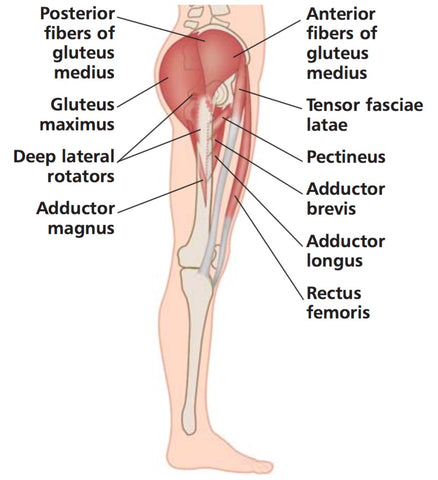Five Stretches for the Hip and Thigh
Posted by Stuart Hinds on

Hip Adductors

Hip Abductors

Hamstring Muscles
Most therapists agree that stretching is a key component of their trigger point treatment protocols.
Here are five simple stretches that we often recommend for the hip and thigh.
If you are suffering from an existing pain condition, always seek professional advice before starting a stretching program. In all cases, start slowly and ease into and out of each stretch.
Enjoy!

TECHNIQUE
Lie on a bench on your side. Allow the top leg to fall forward and off the side of the bench.
Try not to let your leg fall too far forward and use the weight of your leg to do the stretching for you.
MUSCLES BEING STRETCHED
Primary muscles: Tensor fasciae latae. Gluteus medius and mininus.
Secondary muscles: Sartorius. Gluteus maximus.
INJURY WHERE STRETCH MAY BE USEFUL
Trochanteric bursitis. Iliotibial band syndrome.

TECHNIQUE
Sit with one leg straight and hold onto your other ankle. Pull it directly towards your chest.
Use your hands and arms to regulate the intensity of this stretch. The closer you pull your foot to your chest, the more intense the stretch.
MUSCLES BEING STRETCHED
Primary muscles: Piriformis. Gemellus superior and inferior. Obturator internus and externus. Quadratus femoris.
Secondary muscle: Gluteus maximus.
INJURY WHERE STRETCH MAY BE USEFUL
Piriformis syndrome. Snapping hip syndrome. Trochanteric bursitis.

TECHNIQUE
Hold onto the pole with one hand, while standing next to a pole or door jam. Keep your feet together, and lean your hips away from the pole. Keep your outside leg straight and bend your inside leg slightly.
It is important not to bend forward during this stretch. Keep your body upright and concentrate on pushing your hips away from the object you are holding on to.
MUSCLES BEING STRETCHED
Primary muscles: Tensor fasciae latae. Gluteus medius and mininus.
Secondary muscle: Sartorius.
INJURY WHERE STRETCH MAY BE USEFUL
Trochanteric bursitis. Iliotibial band syndrome.

TECHNIQUE
Stand upright and cross one foot behind the other. Lean towards the foot that is behind the other.
If need be, hold onto something for balance. This will allow you to concentrate on the stretch, instead of worrying about falling over.
MUSCLES BEING STRETCHED
Primary muscles: Tensor fasciae latae. Gluteus medius and minimus.Secondary muscle: Sartorius.
INJURY WHERE STRETCH MAY BE USEFUL
Trochanteric bursitis. Iliotibial band syndrome.

TECHNIQUE
Stand with your feet shoulder-width apart. Bend forward and reach towards the ground.
This position puts a lot of stress on the lower back muscles and the knees. Avoid this stretch if you have lower back pain or knee pain.
MUSCLES BEING STRETCHED
Primary muscles: Semimembranosus. Semitendinosus. Biceps femoris.
Secondary muscles: Gastrocnemius. Gluteus maximus. Iliocostalis lumborum. Spinalis thoracis. Interspinales. Multifidus.
INJURY WHERE STRETCH MAY BE USEFUL
Lower back muscle strain. Lower back ligament sprain. Hamstring strain. Calf strain.
About the author
Stuart Hinds is one of Australia’s leading soft tissue therapists, with over 27 years of experience as a practitioner, working with elite sports athletes, supporting Olympic teams, educating and mentoring others as well as running a highly successful clinic in Geelong.
Stuart has a strong following of practitioners across Australia and globally who tap into his expertise as a soft-tissue specialist. He delivers a range of highly sought after seminars across Australia, supported by online videos, webinars and one-on-one mentoring to help support his colleagues to build successful businesses.
In 2016, Stuart was awarded a lifetime membership to Massage & Myotherapy Australia for his significant support and contribution to the industry.
This trigger point therapy blog is intended to be used for information purposes only and is not intended to be used for medical diagnosis or treatment or to substitute for a medical diagnosis and/or treatment rendered or prescribed by a physician or competent healthcare professional. This information is designed as educational material, but should not be taken as a recommendation for treatment of any particular person or patient. Always consult your physician if you think you need treatment or if you feel unwell.
Liquid error (sections/article-template line 26): Could not find asset snippets/relatedblogs.liquidShare this post
- 0 comment
- Tags: Hip, NAT Hip Protocol, Stretching
